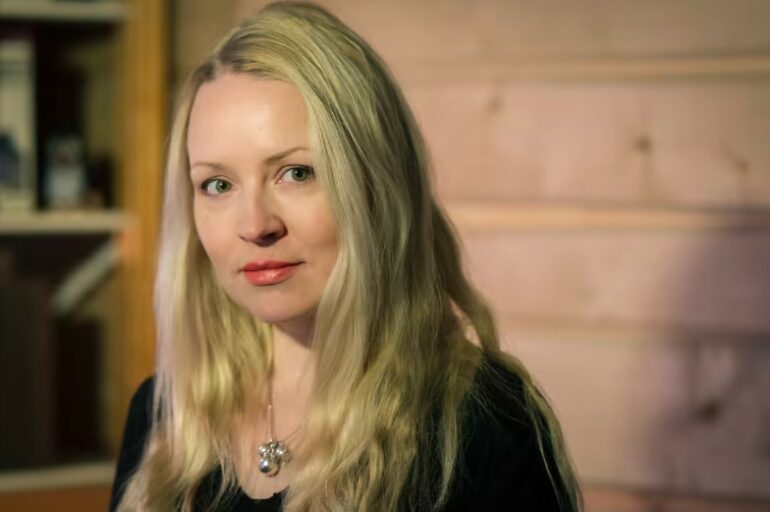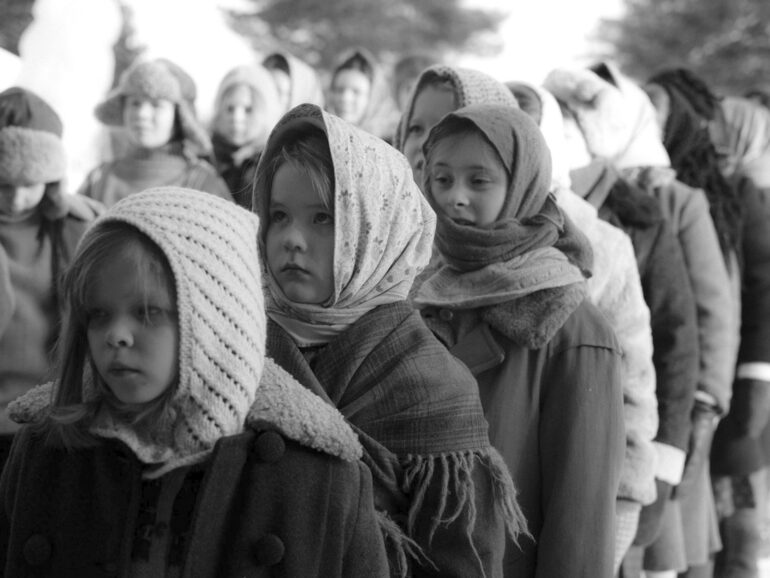WRITTEN BY: Annika Pham
The first ever film in Skolt Sámi dialect is having its world premiere June 9 at Tribeca’s International Narrative competition.
Well-known internationally for the documentaries Canned Dreams (2012) and Kajsa’s Enchanted Forest which opened the Berlinale NATIV section in 2017 and won a Jussi for best documentary, Skolt Sámi director Katja Gauriloff brings to New York’s Tribeca Int’l Film Festival the unheard voice of her people through Je’vida, a beautifully black-and-white lensed story of empowerment by ancestors, resilience and collective memory.
The story of the character Je’vida is told through three timelines. The little girl aged 10 as she grows up among her Skolt Sámi people in Lapland, her in her 30s, and her aged 76, as a frustrated woman who has repressed her past and identity to the point of changing her name to Lida.
When forced to drive back to her birthplace in Lapland with her niece to empty the family home, Lida has to come to terms with her roots. She remembers the warm memories of her ancestors and bond with her grandfather, but also the traumatic experience of forced assimilation at a boarding school.
The film was shot mostly with non-professionals but also with Seidi Haarla (Compartment No6), and Sanna-Kaisa Palo (On the Road to Emmaus). It was co-written by Gauriloff with Niillas Holmberg.
Je’vida was produced by Joonas Berghäll for Oktober, with co-financing from Yle, the Finnish Film Foundation and Nordisk Film & TV Fond.Future Film will release it this fall.
We spoke to Gauriloff ahead of her film’s world premiere at Tribeca.
First of all, how does it feel to attend a major int’l festival like Tribeca with the first ever film in Skolt Sámi language?
Katja Gauriloff: I’m super excited. It’s a major festival in a major city, and I will show the film for the first time ever to an audience. However, I haven’t yet had a chance to show it to my people, so I have mixed feelings.
What is your personal experience with the Skolt Sámi language?
KG: It’s my grandmother’s tongue, on my mum’s side. I have not been able to learn Skolt Sámi as my parents didn’t want to speak it to me and I couldn’t study it. So it was always a kind of secret language. But nowadays, I’m studying it online and so does my 11-year-old son. We’re trying to make good for what we lost because of forced assimilation into Finnish culture. Today, only 200-300 people in Finland can speak Skolt Sámi.
That must have been challenging for filming-which explains perhaps why the cast consists mostly of non-professional actors…
KG: Yes the casting process was difficult. Almost all Sámi people in the film are relatives. I was very lucky with their natural screen presence, as I had no other option than to use them. No kid speaks Skolt Sámi, but we had Agafia Niemenmaa - a distant cousin - who does, and she was the first I contacted for the casting. She is a natural actress.
This is your second film after your acclaimed documentary Kaisa’s Enchanted Forest where you go back to your roots and bring to the screens not only the beautiful Skolt Sámi traditions, but the notion of generational legacy. Why did you turn to fiction with Je’vida? How did you build the storyline with Niillas Holmberg and what’s the share of personal /fiction narrative?
KG: I have been dreaming about this film for nearly 20 years. The script is partly based on fragments of true stories about my mother's childhood and other stories, but the inspiration for the whole film actually came from a story that my mum told me. When my grandfather died, they put him in a shed and she went to visit him at night. As a kid, I started to imagine what their conversations would be about. So this is how the script for Je’vida started to emerge.
I took care of the storyline and structure, while Niillas who is a renowned Sámi poet, author and singer, handled the dialogue-especially the philosophical talk between little Je’vida and her grandfather. It was Niillas’ first film contribution. Being Sámi, we both connected naturally, so our collaboration was very easy.
Is the grandfather the spiritual advisor and healer that plays a central role in Sámi tradition?
KG: Yes our ancestors are always with us. This film is a fiction continuation of Kaisa’s Enchanted Forest, and in that film, my great grandmother is the spiritual leader. Here it is the grandfather. He is natural philosopher, in connection with nature and the ‘old world’.
Why did you choose a three-timeline structure, with Je’vida at three stages of her life?
KG: It is three time-lines, but at the same time, those time periods are just one. When I go to my family cabin, we hear the steps, the voices of our ancestors, we connect with them. So in a way, the different time periods in Je’vida’s life exist at the same time.
Is the film first and foremost about trauma - through the story of Je’Vida and the Skolt Sámi forced to break away from their ancestors and to assimilate into Finnish culture?
KG: All Sámi people know about life between two cultures and being forced to leave behind our land and native culture.
At the end of the film, you say that the boarding schools that most Skolt Sámi kids were forced to join in post-war Finland, were responsible for cutting two generations of Sámi from their culture and that the last boarding school closed only in the 1980s. You also say that the Finnish state has not recognised its responsibility in the damage that it caused to the Sámi people. Do you hope the film will play a crucial part in the necessary reconciliation and healing process?
KG: The boarding schools gathered most Skolt Sámi kids who lived dispatched in the countryside. This forced education and assimilation happened across three generations.
Regarding reconciliation, I don’t believe in it. First of all, the Finnish government has to fix the Sámi Parliament Act and enshrine the right of Sámi self-determination into law. We have fought for this for over a decade. Until Finland fixes the law and stops colonizing our territory, reconciliation simply can’t happen.
Therefore, I’m not so optimistic about art and film’s ability to contribute to reconciliation on this particular topic. But it is essential to create a space for dialogue and understanding.
The film does have a beautiful story about the role of ancestors and tradition, so perhaps this is a better way to touch people’s hearts and minds than pure politics.
What is planned around the film’s release, to engage people and raise awareness on the fate of Skolt Sámi people?
KG: The film is in the hands of the production company Oktober and the distributor Future Film. It will premiere probably this autumn, and I hope it will be screened to my people.
Could you discuss your artistic choices-filming in black& white etc?
KG: Kajsa’s Enchanted Forest used 16mm archive material. I fell in love with this black and white square framing. I wanted to film Je’vida in a similar way.
The Sámi people have been the focus of attention from many photographers over time, but those were outsiders. I felt it was time for me as a Sámi to decolonise the material and make it ours.
Who was your cinematographer?
KG: Tuomo Hutri [The Fencer, Helsinki Syndrome]. I have worked with him in the past and he will come with me to Tribeca. He is an amazing human being who connects with people on set, and a great artist.
What’s next for you?
KG: I think my next project will be fiction again. Also, I have a three-year grant to write, so I will take my time to write. I’m tempted to dig deeper into my great grandmother’s stories. I’m also inspired by Japanese 60s horror movies. Let’s see!
SEE THE TRAILER

